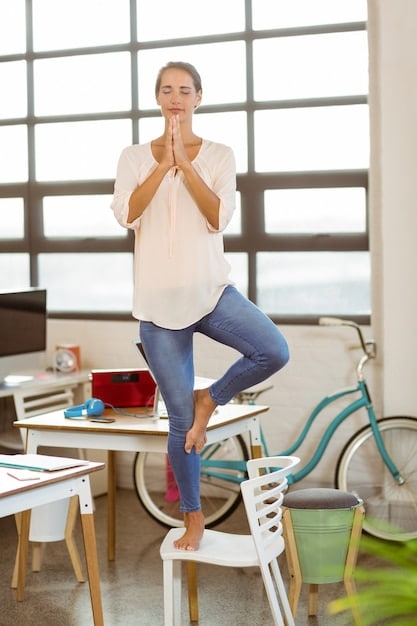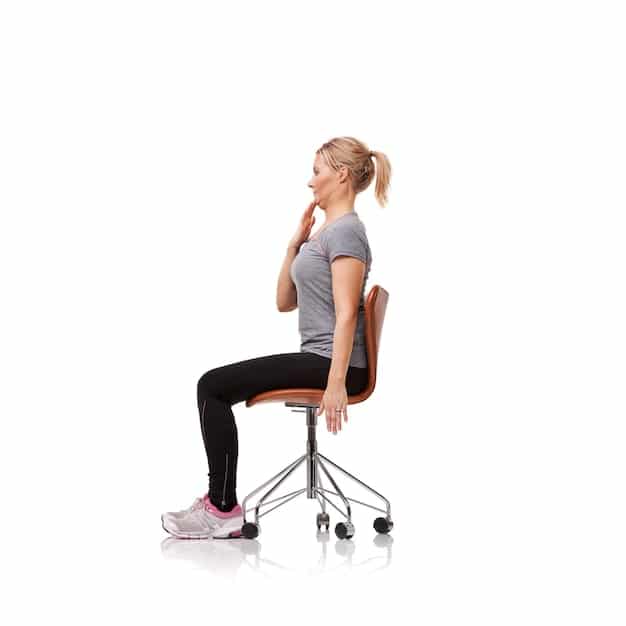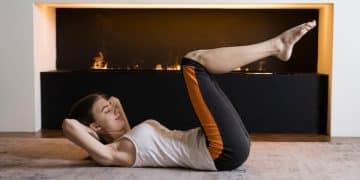Yoga for Desk Workers: 5 Stretches to Combat Sedentary Life

Yoga for desk workers offers a practical solution to combat the adverse effects of a sedentary lifestyle by incorporating simple stretches that enhance flexibility, reduce muscle tension, and improve overall well-being, making it an ideal approach to revitalize the body and mind during long hours in the office.
Are you a desk worker feeling the strain of a sedentary lifestyle? Yoga for desk workers provides a fantastic way to counteract the stiffness and discomfort that comes with sitting for prolonged periods. Integrating simple yoga stretches into your workday can make a significant difference in your physical and mental well-being.
The Impact of Sedentary Lifestyle on Desk Workers
A sedentary lifestyle can take a significant toll on your body and mind. As desk workers, we often find ourselves spending hours sitting, which can lead to a variety of health issues. Understanding these impacts is the first step in addressing them.
Physical Effects of Prolonged Sitting
Sitting for extended periods can cause several physical problems. From muscle stiffness to poor circulation, the effects can be quite detrimental.
- Muscle stiffness and pain, especially in the neck, shoulders, and back.
- Poor circulation, leading to swelling in the legs and feet.
- Increased risk of musculoskeletal disorders.
- Weight gain and metabolic slowdown.
Regular movement and stretching can help mitigate these physical effects, keeping your body more comfortable and functional throughout the day.
Mental and Emotional Effects of a Sedentary Job
It’s not just the body that suffers from a sedentary lifestyle; the mind can be equally affected. Here’s how sitting for long periods can impact your mental and emotional well-being:

- Increased feelings of stress and anxiety.
- Reduced energy levels and increased fatigue.
- Decreased focus and concentration.
- Potential links to depression and other mood disorders.
Taking short breaks for physical activity, like yoga stretches, can help refresh your mind and improve your overall mood.
In conclusion, being aware of both the physical and mental impacts of a sedentary lifestyle is crucial for desk workers. By understanding these effects, you can take proactive steps to counteract them and maintain a healthier, happier life.
Introduction to Yoga for Desk Workers
Yoga offers a practical and effective way to combat the negative effects of a sedentary lifestyle. Specifically designed for desk workers, these yoga practices can be easily integrated into your daily routine. Discover how simple stretches can rejuvenate your body and mind, right at your desk.
Benefits of Yoga Stretches at the Office
Incorporating yoga stretches into your workday can bring numerous benefits. These include improved posture, reduced stress, and increased energy levels.
Yoga can do wonders for your body and mind, especially when you’re stuck at a desk all day. It’s not just about exercise; it’s about bringing mindfulness and balance into your work life.
- Improved posture and spinal alignment.
- Reduced muscle tension and pain.
- Increased flexibility and range of motion.
- Stress relief and mental clarity.
Even a few minutes of yoga each day can make a significant difference in your overall well-being.
How to Incorporate Yoga into Your Workday
Integrating yoga into your workday doesn’t require a lot of time or equipment. Simple strategies can help you make it a regular part of your routine.
Start small by setting reminders to stretch every hour. You can perform many yoga poses right at your desk without disrupting your work too much.
- Set alarms or calendar reminders to take short stretch breaks.
- Use your lunch break for a longer yoga session, if possible.
- Encourage colleagues to join you for group stretching.
- Utilize seated yoga poses that can be done discreetly.
Yoga for desk workers is a convenient and effective way to enhance your well-being. By taking small, consistent actions, you can avoid the pitfalls of a sedentary job and feel more vibrant and focused throughout the day.
Stretch 1: Seated Spinal Twist
The Seated Spinal Twist is an excellent stretch for relieving tension in the back and shoulders. This simple pose can be done right in your chair, making it perfect for desk workers. Relieve tension and improve flexibility with this easy, seated yoga pose.
How to Perform the Seated Spinal Twist
Follow these steps to properly perform the Seated Spinal Twist. Ensure you maintain good posture and breathe deeply throughout the stretch.
- Sit upright in your chair with your feet flat on the floor.
- Inhale and lengthen your spine.
- Exhale and twist your torso to the right, placing your left hand on your right knee and your right hand on the back of the chair.
- Hold the twist for 30 seconds, breathing deeply.
- Release and repeat on the other side.
This stretch helps to mobilize the spine and release tension in the back muscles.
Benefits of the Seated Spinal Twist
The Seated Spinal Twist offers multiple benefits, including reduced back pain and improved posture. Here’s how you can benefit from this twist.
This twist is particularly beneficial if you spend long hours sitting, as it helps to counteract the compression of the spine.

- Relieves tension in the back, shoulders, and neck.
- Improves spinal mobility and flexibility.
- Stimulates abdominal organs, aiding digestion.
- Reduces stress and promotes relaxation.
The Seated Spinal Twist is a great way to introduce yoga for desk workers into your everyday routine. With its ease and numerous benefits, it’s an ideal stretch for anyone looking to improve their well-being at work.
Stretch 2: Neck and Shoulder Rolls
Neck and shoulder rolls are simple yet effective stretches for relieving tension in the neck and upper back. These can be performed anytime and anywhere, making them ideal for desk workers.
Simple Steps for Neck Rolls
Neck rolls are one of the simplest exercises and can be done in a sitting or standing position. Gently stretch and loosen your neck muscles for instant relief.
These rolls help to alleviate stiffness and pain caused by prolonged sitting at a desk.
- Sit or stand with your spine straight.
- Gently drop your chin to your chest.
- Slowly roll your right ear towards your right shoulder.
- Continue rolling your head back and then to your left shoulder.
- Repeat this circular motion 5-10 times.
Performing Effective Shoulder Rolls
Shoulder rolls can help to relieve tension in the upper back and shoulders. Use these rolls to improve mobility and reduce stiffness.
Rolling your shoulders regularly can counteract the hunching posture often associated with desk work.
- Sit or stand with your arms relaxed at your sides.
- Roll your shoulders forward in a circular motion for 5-10 repetitions.
- Then, roll your shoulders backward for another 5-10 repetitions.
- Focus on smooth, controlled movements.
Regular neck and shoulder rolls can significantly reduce muscle stiffness and tension, promoting relaxation and improved posture. Incorporating these stretches into your workday can help you stay comfortable and focused.
Stretch 3: Wrist and Finger Stretches
Wrist and finger stretches are essential for desk workers who spend a lot of time typing. These stretches can prevent carpal tunnel syndrome and reduce hand fatigue.
Why Wrist Stretches Are Important
Wrist stretches are vital for maintaining healthy, pain-free wrists. Prevent strain and discomfort with these easy-to-do stretches.
These exercises help to counteract the repetitive motions that lead to wrist pain and carpal tunnel syndrome.
- Extend your arm straight out in front of you, palm up.
- Use your other hand to gently bend your wrist downwards, pointing your fingers towards the floor.
- Hold for 15-30 seconds.
- Repeat, bending your wrist upwards, pointing your fingers towards the ceiling.
Finger Stretches for Desk Workers
Finger stretches can help to relieve stiffness and improve dexterity. Keep your fingers nimble and pain-free with these simple exercises.
Stretching your fingers regularly can prevent cramps and improve overall hand function.
- Make a fist and then slowly open your hand, spreading your fingers wide.
- Hold for a few seconds and repeat 10-15 times.
- Gently massage each finger from base to tip to improve circulation.
- Try finger extensions by placing your hand flat on the desk and lifting each finger individually.
Incorporating wrist and finger stretches into your daily routine can help maintain hand and wrist health, preventing pain and improving productivity at work.
Stretch 4: Chest Opener
The chest opener stretch helps counteract the hunched posture common among desk workers. It improves breathing and posture, promoting a sense of openness and relaxation.
How to Perform a Chest Opener
Opening up your chest is vital when you are at your desk because you tend to slouch while staring at a screen. Here are steps on how to perform a chest opener.
The chest opener can be done sitting or standing, making it a versatile stretch for desk workers.
- Sit or stand tall with your feet flat on the floor.
- Clasp your hands behind your back, interlocking your fingers.
- Gently pull your shoulders back and down, lifting your chest towards the ceiling.
- Hold for 20-30 seconds, breathing deeply.
- Release and repeat 3-5 times.
Benefits of Opening Your Chest
An open chest has many benefits aside from improved posture. Here are several great reasons to perform chest openers throught the day.
Regular chest openers help to counteract the effects of prolonged sitting and improve overall posture.
- Improves posture by counteracting slouching.
- Increases lung capacity, aiding in deeper breathing.
- Relieves tension in the chest and shoulders.
- Promotes a sense of openness and relaxation.
By incorporating chest openers into your routine, you can counteract the negative effects of sitting and promote better breathing and posture, leading to increased comfort and productivity.
Stretch 5: Leg Extensions
Leg extensions are great for improving circulation and reducing stiffness in the legs, which are common issues for desk workers. These stretches can be easily performed while seated.
Performing Leg Extensions at Your Desk
Leg extensions are a simple and effective way to combat leg stiffness while at your desk. The simplicity of this stretch makes for easy implementation.
Regular leg extensions can help to improve blood flow and reduce the risk of swelling and discomfort.
- Sit upright in your chair with your feet flat on the floor.
- Extend one leg straight out in front of you, parallel to the floor.
- Hold for a few seconds, then slowly lower your leg back down.
- Repeat 10-15 times on each leg.
- You can also add ankle rotations while your leg is extended for added benefit.
Benefits of Leg Extension
Stretching your legs has profound impacts on long term health. Here are several benefits to leg extensions.
These extensions are particularly beneficial for those who spend long hours sitting, as they help to counteract the effects of poor circulation.
- Improves circulation in the legs and feet.
- Reduces stiffness and discomfort.
- Strengthens leg muscles.
- Prevents swelling and fatigue.
Leg extensions promote better circulation and reduce stiffness, helping you stay comfortable and energized throughout the workday. Combining this stretching with the other four examples of yoga for desk workers will improve quality of life.
| Key Point | Brief Description |
|---|---|
| 🧘 Seated Spinal Twist | Relieves back tension, improves spinal mobility. |
| 🔄 Neck & Shoulder Rolls | Reduces neck and upper back stiffness. |
| ✍️ Wrist & Finger Stretches | Prevents carpal tunnel, reduces hand fatigue. |
| 💪 Leg Extensions | Improves circulation, reduces stiffness in legs. |
FAQ
▼
Yoga helps to counteract the negative effects of prolonged sitting by improving posture, reducing muscle tension, and increasing circulation. It also offers mental benefits such as stress reduction and improved focus.
▼
Ideally, desk workers should incorporate yoga stretches into their daily routine, aiming for at least 5-10 minutes every 1-2 hours. Even short, frequent breaks can make a significant difference in comfort and well-being.
▼
No special equipment is usually needed. Most yoga stretches for desk workers can be performed using just your chair and desk. A yoga mat can be useful for floor-based stretches during longer breaks.
▼
If you experience pain during a stretch, stop immediately. It’s important to listen to your body and avoid pushing yourself too hard, particularly when starting a new exercise routine. Consult a healthcare professional if pain persists.
▼
Yes, many desk workers find that incorporating yoga stretches helps to improve their productivity by reducing stress, increasing energy levels, and enhancing focus. Regular stretching can lead to a more comfortable and productive workday.
Conclusion
Incorporating these five simple yoga stretches into your workday can significantly improve your physical and mental well-being. By taking short, regular breaks to stretch and move, you’ll combat the negative effects of a sedentary lifestyle, enhance your comfort, and boost your overall productivity. Give these stretches a try and experience the benefits of yoga for desk workers firsthand!





